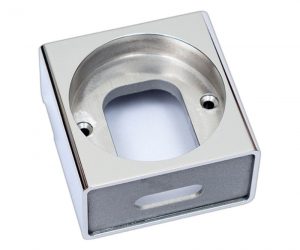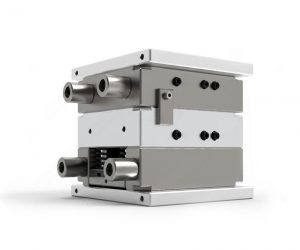We shall introduce you to the three-plate injection mold in detail, which is an injection mold composed of three independent plates. You will learn about the advantages, disadvantages, areas of application and factors to consider when designing this mold type. from mold7.
First, let us understand the advantages of three-plate injection molds. Compared with traditional two-plate injection molds, three-plate injection molds have higher production efficiency and better product quality. Due to the particularity of its structure, the three-plate injection mold can achieve more complex product shapes and structures to meet the needs of different industries. In addition, the three-plate injection mold also has a longer service life because it is better able to disperse injection pressure and reduce mold wear and damage.
However, the three-plate injection mold also has some disadvantages. First, due to its complex structure, the manufacturing cost is relatively high. Secondly, since more moving parts and control systems are required, the difficulty of operation and maintenance also increases accordingly. In addition, due to the larger size of the mold and the larger footprint, it may not be suitable for production environments with limited space.
In terms of application fields, three-plate injection molds are widely used in automobiles, home appliances, electronic products, medical equipment and other industries. For example, in automobile manufacturing, three-plate injection molds can be used to manufacture automobile parts, such as engine parts, instrument panels, etc. In home appliance manufacturing, three-plate injection molds can be used to manufacture the outer casings and internal structures of refrigerators, washing machines and other home appliances. In the manufacturing of electronic products, three-plate injection molds can be used to manufacture mobile phone cases, computer cases, etc. In medical device manufacturing, three-plate injection molds can be used to manufacture syringes, surgical instruments, etc.
When designing a three-plate injection mold, the following factors need to be considered. The first is the shape and structure of the product. The structural form and movement mode of the mold need to be determined according to the requirements of the product. The second is the control of injection pressure and speed. It is necessary to ensure that the pressure and speed during the injection process are stable to ensure product quality and molding effect. In addition, the cooling system and heating system of the mold also need to be considered to ensure the temperature control and production efficiency of the mold. The last step is the material selection and processing technology of the mold. Suitable materials and processing technology need to be selected to ensure the strength and durability of the mold.
To sum up, the three-plate injection mold is a type of injection mold with higher production efficiency and product quality. Despite some shortcomings, its wide range of applications and design flexibility make it an indispensable tool in many industries. Through reasonable design and operation, the advantages of the three-plate injection mold can be fully utilized to improve production efficiency and product quality.
What is a Three Plate Injection Mould?
A three plate injection mould is a type of injection mould that consists of three separate plates – the core plate (B plate), the cavity plate (A plate), and the runner plate. The core plate is located on the moving side of the mould, while the cavity plate is on the stationary side. The runner plate is placed between the core and cavity plates, and it contains the runner system that distributes the molten plastic material to the cavities.
A three plate injection mould has two parting lines, one between the core and runner plates, and another between the runner and cavity plates. This allows the runner system to be automatically separated from the moulded part when the mould opens. The runner system can then be ejected by pins or dropped by gravity.
How Does a Three Plate Injection Mould Work?
The working principle of a three plate injection mould is similar to that of a two plate injection mould, except that it has an additional plate and parting line. The following steps describe the basic process of a three plate injection moulding:
- The mould closes and clamps with sufficient force to withstand the injection pressure.
- The molten plastic material is injected through the sprue bushing into the runner system on the runner plate.
- The material flows through the runners and gates into the cavities on the cavity plate, filling them completely.
- The material cools and solidifies in the cavities, forming the desired parts.
- The mould opens and separates along the two parting lines. The core and runner plates move away from the cavity plate, leaving the parts attached to the core plate. The runner system remains on the runner plate.
- The parts are ejected from the core plate by ejector pins or other mechanisms. The runner system is ejected from the runner plate by pins or dropped by gravity.
- The mould closes again and repeats the cycle.
Advantages and Disadvantages of a Three Plate Injection Mould
A three plate injection mould has some advantages and disadvantages compared to a two plate injection mould. Some of them are:
Advantages
- It allows for automatic separation and ejection of the runner system, reducing manual labor and recycling costs.
- It can accommodate multiple cavities with different shapes and sizes on one mould, increasing productivity and flexibility.
- It can produce parts with complex geometries, such as undercuts or holes, without using side cores or slides.
- It can use pinpoint gates or edge gates that leave minimal gate marks on the parts, improving aesthetic quality.
- It can reduce pressure loss and material waste by using shorter runners and smaller gates.
Disadvantages
- It is more expensive and complex to design, manufacture, and maintain than a two plate injection mould.
- It requires more clamping force and injection pressure than a two plate injection mould due to its additional parting line.
- It has longer cycle time than a two plate injection mould due to its additional opening and closing movement.
- It may cause more wear and tear on the mould components due to its additional movement.
Applications of a Three Plate Injection Mould
A three-plate injection mold, also known as a three-plate mold or triple-plate mold, is a type of injection molding tool used to produce complex plastic parts with multiple components or features. This specialized mold design consists of three plates: the cavity plate, the core plate, and the runner plate. The runner plate serves as a gating system that allows the mold to open in three stages, enabling the ejection of the molded part while leaving the runners and gates intact for subsequent injection cycles. The unique design and functionality of three-plate injection molds make them suitable for a wide range of applications across various industries.
One of the primary applications of a three-plate injection mold is in the production of multi-component or multi-color plastic parts. By incorporating multiple cavities and gating systems in a single mold, manufacturers can produce complex parts with different materials or colors in one injection molding cycle. This capability is particularly advantageous in industries such as automotive, where the demand for visually appealing interior components or functional parts with varying material properties is high. Examples of multi-component automotive parts produced using three-plate molds include gearshift knobs with integrated buttons or controls, door handles with soft-touch surfaces, and dashboard components with different colors and textures.
The medical industry also benefits from the versatility of three-plate injection molds. Medical devices often require parts with intricate designs and specialized materials, making three-plate molds an ideal choice for producing such components. Overmolded medical devices, such as syringe plungers with integrated stoppers or surgical instruments with soft grips, can be efficiently manufactured using a three-plate mold. The ability to combine different materials in one molding cycle not only improves functionality but also reduces assembly and post-processing steps, streamlining the manufacturing process and enhancing product consistency.
Another significant application of three-plate injection molds is in the consumer electronics sector. With the ever-increasing demand for innovative and aesthetically appealing electronic devices, manufacturers rely on three-plate molds to create components with intricate designs and multiple colors. Keyboards with soft-touch keys, remote controls with tactile buttons, and electronic device housings with integrated logos or branding are just a few examples of consumer electronics products that can be efficiently produced using a three-plate mold. The mold's ability to accommodate complex part geometries and varying material combinations makes it an attractive option for consumer electronics manufacturers seeking to stand out in a competitive market.
Additionally, three-plate injection molds find applications in the production of household appliances, sports equipment, and a wide range of consumer goods. Manufacturers can leverage the mold's design flexibility to create products with enhanced functionality, improved ergonomics, and eye-catching aesthetics. From soft-grip handles on kitchen appliances to dual-color packaging closures, the possibilities are virtually limitless with three-plate injection molds.
In conclusion, the applications of a three-plate injection mold span across diverse industries, where the demand for complex plastic parts with multiple components or colors is prevalent. Whether in automotive, medical, consumer electronics, or other sectors, the versatility of three-plate molds allows manufacturers to create innovative and high-quality products that meet the evolving needs and preferences of consumers. As technology and design continue to advance, three-plate injection molds will continue to play a significant role in driving product innovation and expanding the possibilities in the world of injection molding.
Design Considerations for a Three Plate Injection Mould
When designing a three plate injection mould, some of the factors that need to be considered are:
- The number, size, shape, and location of the cavities and the runner system.
- The type, size, and location of the gates and the sprue bushing.
- The alignment and movement of the core, cavity, and runner plates.
- The cooling, venting, and ejection systems for the parts and the runner system.
- The material properties, shrinkage, and warpage of the parts and the runner system.
- The clamping force, injection pressure, and cycle time of the moulding process.
Some of the design guidelines that can help optimize the performance and quality of a three plate injection mould are:
- Use a balanced runner system that ensures equal flow and pressure distribution to all cavities.
- Use pinpoint gates or edge gates that minimize gate marks and stress concentration on the parts.
- Use guide pins and bushings to ensure proper alignment and smooth movement of the mould plates.
- Use adequate draft angles and ejector pins to facilitate easy ejection of the parts and the runner system.
- Use sufficient cooling channels and air vents to control the temperature and pressure of the mould.
- Use appropriate mold polishing and surface finish to reduce friction and wear on the mould components.
Conclusion
A three plate injection mould is a type of injection mould that consists of three separate plates – the core plate, the cavity plate, and the runner plate. It has two parting lines that allow for automatic separation and ejection of the runner system from the moulded parts. It can produce parts with complex shapes, multiple cavities, minimal gate marks, or different colors or materials. However, it is also more expensive, complex, and time-consuming than a two plate injection mould. Therefore, it is important to weigh the advantages and disadvantages of a three plate injection mould before choosing it for your injection moulding project.


